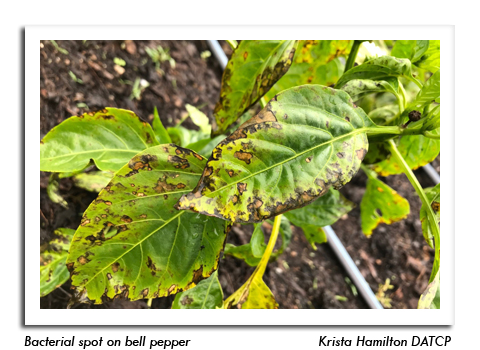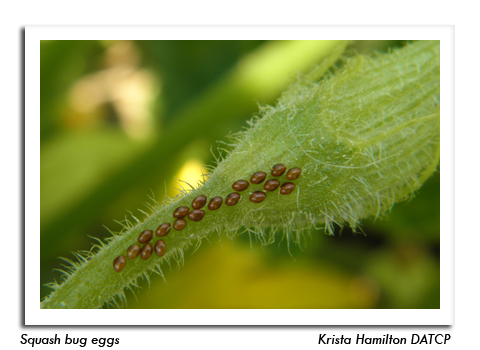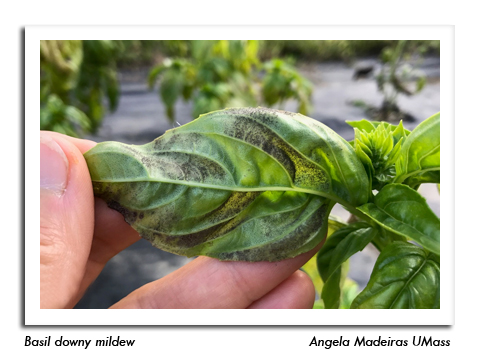
 |
|
|
Vegetables
Volume 64 Number 11 Date 07/11/2019 STRIPED CUCUMBER BEETLE - Gardeners and farmers should continue scouting cucurbit plants for these yellow and black striped beetles that transmit bacterial wilt. Surveys indicate economic infestations of 2-4 beetles per plant are common in southern and western Wisconsin gardens. Cucurbits infected with bacterial wilt first exhibit flagging of individual lateral leaves, followed by wilting and death of the entire plant. The treatment threshold for cucumber beetles is one beetle per plant in melons, cucumber, Hubbard and butternut squash, and younger pumpkins. For other squash varieties, watermelon and older pumpkins, the threshold is five adults per plant. TOMATO HORNWORM - Moths have begun laying eggs on the undersides of tomato leaves in southern Wisconsin. Tomato growers who have experienced past problems with this pest should start inspecting plants for the smooth, spherical, pale green eggs deposited individually on the lower surface of leaves. Once the eggs hatch, the larvae grow rapidly and can quickly defoliate plants. Prompt removal of the larvae is the best control measure. BACTERIAL SPOT - This disease is developing on bell pepper foliage in a La Crosse County community garden for the second year in a row. Bacterial leaf spot (BLS) is a very common, destructive disease of peppers in the U.S. Symptoms include leaf spots that initially appear water-soaked, then become brown and irregularly shaped. Infected leaves often turn yellow and drop. Raised, scab-like spots may develop on fruits, reducing yield and exposing peppers to potential sunscald. In severe cases, complete crop failure can occur. Infected seed is an important source of the bacterium that causes BLS in pepper. Therefore, the use of disease-free seed and transplants are important in BLS management. Infected plant debris and weeds are additional sources of the pathogen and must also be eliminated to reduce the amount of the pathogen available to initiate disease. ONION MAGGOT - Second-generation flies are emerging near Madison, La Crosse, Spring Green and other locations where 1,950 GDD (simple base 40°F) have been surpassed. Emergence is anticipated near Fond du Lac, Eau Claire and Hancock in the week ahead. Management of the summer generation is less critical than spring and fall populations since egg desiccation and mortality rates are higher at warmer temperatures, but season-long sanitation is still important for preventing future infestations. Second-brood eggs are deposited near previously-damaged onions. SQUASH BUG - Populations of this vine crop pest typically increase sharply by mid-July with the appearance of many small nymphs. An average of one egg mass per plant when plants are flowering is recommended as the basis for initiating treatment. For gardens, hand picking and destroying the bugs and their eggs is most effective. Another option is to place cardboard or newspaper on the ground next to the plants. At night the squash bugs will collect beneath the cardboard and can be destroyed in the morning. Organic growers may use directed applications of pyrethrum (PyGanic) or the pre-mix with azadirachtin (Azera). Refer to UWEX publication A3422 "Commercial Vegetable Production in Wisconsin" for a list of registered insecticides. EUROPEAN EARWIG - Rainy weather this season is contributing to the high populations of this nocturnal, moisture-favoring pest. Earwigs are prevalent in vegetable and flower gardens, greenhouses and basements, as are reports of leaf and flower damage on arugula, beans, cabbage, lettuce, hostas, marigolds, potatoes and other favored hosts. BASIL DOWNY MILDEW - This disease was confirmed by the UW on basil in south-central Wisconsin last week. First reported in Wisconsin in 2010, basil downy mildew (BDM) can rapidly destroy entire basil crops. Diagnostic characteristics include yellowing and downward curling of foliage and grayish-purple, fuzzy sporulation on leaf undersides. This disease can spread by infected seed, transplants or by windblown spores and thrives under moderate temperatures and high humidity, with symptoms progressing from the lower leaves upward. Basil crops should be routinely inspected for yellowed leaves and gray downy growth on the lower leaf surface now that BDM has been found in the state. If basil downy mildew is suspected, the infected plant should be promptly removed and destroyed. Only certain fungicides can protect plants from this disease and treatments must begin before symptoms develop. Harvesting early may be the best option for avoiding losses. For BDM control recommendations, refer to the June 2, 2019 UWEX Vegetable Crop Update: https://wivegdis.wiscweb.wisc.edu/wp-content/uploads/sites/210/2019/06/Update-6-June-2-2019.pdf -- Krista Hamilton, DATCP Entomologist 





|
|
|